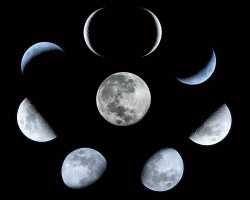Lunar month
In lunar calendars, a lunar month is the time between two identical syzygies (new moons or full moons). The use of the lunar month varies by which culture has utilized the method, the main difference being when the "new" month begins.
Variations
In Middle-Eastern and European traditions, the month starts when the young crescent moon becomes first visible at evening after conjunction with the Sun one or two days before that evening (e.g., in the Islamic calendar). In ancient Egypt the lunar month began on the day when the moon could no longer be seen just before sunrise. Others use a reckoned moon (e.g., the Hebrew calendar), or use a tabular scheme (ecclesiastical lunar calendar). Yet others run from full moon to full moon. Calendars count integer days, so months may be 29 or 30 days in length, in some regular or irregular sequence.
Cycle lengths
However, regardless of the culture, all lunar months approximate the mean length of the synodic month, or how long it takes on average to pass through each phase (new, half, full moon) and back again. It takes 29.53059 days (29 days, 12 hours, 44 minutes and 3 seconds). The moon completes its orbit around the earth in 27.3 days (the sidereal month), but due to the Earth's motion around the sun it has not finished a full cycle until it reaches the point in its orbit where the sun is in the same position.
Terminology
There are several types of lunar month. Usually the term lunar month refers to the synodic month, because it is the cycle of visible moon phases.
- A synodic month is defined as the average time between new moons and has been observed to be 29.53059 days (29 days, 12 hours, 44 minutes, 2.8 seconds) long. A New Moon or a Full Moon happens when the Moon crosses the plane that is perpendicular to Earth's orbital plane and passes through the centers of the Earth and the Sun.
- The draconic month or nodal month is the period in which the Moon returns to the same node of its orbit; the nodes are the two points where the Moon's orbit crosses the plane of the Earth's orbit. Its duration is about 27.21222 days on average.
- The tropical month is the average time for the Moon to pass twice through the same equinox point of the sky. It is 27.32158 days, very slightly shorter than the sidereal month (27.32166) days, because of precession of the equinoxes. Unlike the sidereal month, it can be measured precisely.
- The sidereal month is defined as the Moon's orbital period in a non-rotating frame of reference (which on average is equal to its rotation period in the same frame). It is about 27.32166 days (27 days, 7 hours, 43 minutes, 11.6 seconds). The exact duration of the orbital period cannot be easily determined, because the 'non-rotating frame of reference' cannot be observed directly. However, it is approximately equal to the time it takes the Moon to pass twice a "fixed" star (different stars give different results because all have proper motions and are not really fixed in position).
- An anomalistic month is the average time the Moon takes to go from perigee to perigee - the point in the Moon's orbit when it is closest to Earth. An anomalistic month is about 27.55455 days on average.
A synodic month is longer than a sidereal month because the Earth-Moon system is orbiting the Sun in the same direction as the Moon is orbiting the Earth. Therefore, the Sun appears to move with respect to the stars, and it takes about 2.2 days longer for the Moon to return to the same apparent position with respect to the Sun.
A draconic month is shorter than a sidereal month because the nodes move in the opposite direction as the Moon is orbiting the Earth, one revolution in 18 years. Therefore, the Moon returns to the same node slightly earlier than it returns to the same star.
An anomalistic month is longer than a sidereal month because the perigee moves in the same direction as the Moon is orbiting the Earth, one revolution in nine years. Therefore, the Moon takes a little longer to return to perigee than to return to the same star.

